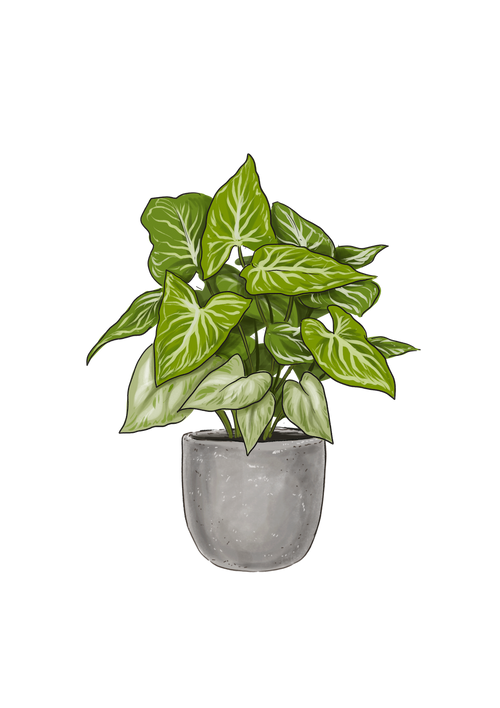Syngonium Care Guide

-
Light : Medium
Indoors: Add this one near a window in bright, indirect light. Outside: Position this one under a canopy of trees in a hanging basket or covered patio to enjoy the vining. Bring in when outside temperatures dip below 60° F.
-
Water : Medium
Use filtered, bottled, or tap water sitting 24 hours to release the chemicals and water enough that the water discharges out of the drainage holes. Once the water is fully drained, replace them into the cache or decorative pot.
-
Humidity : Medium
Add a pebble tray under the grower pot to add humidity to the air. Group with several plants to raise the humidity. Mist with filtered, nonchlorinated water.
-
Temp : 60℉ - 85℉
This plant likes warm, humid conditions to thrive.
-
Zone : 9|10|11
Outside: Keep in full shade on a patio out of direct sunlight to prevent leaf burn where nights are above 60°F.
-
Fertilizer : Monthly
Apply at half-strength a balanced, liquid fertilizer especially formulated for indoor plants every month during the growing season between early spring and fall. A slow release fertilizer can be used as a top dressing instead of a liquid fertilizer.
-
Repotting : 2 Years
When receiving the Syngonium "Neon Robusta" plant, do not repot immediately but wait at least 6-12 months or if the roots are beginning to get crowded and growing through the drainage holes. Repot in the spring, using a 2 inches bigger pot to keep the roots drier. (Too big of a pot could cause the soil to dry slower, which is not helpful.) Place a piece of screening at the bottom of the container over the drainage hole to secure the soil and allow to drain. Use a well-draining indoor potting mix with perlite to help with drainage. Water your plant in the old pot before transferring over and let sit an hour. Add soil to the bottom to elevate the root ball. Lift the plant and release the roots against the existing planter. Use a clean knife or garden trowel to wedge between the pot and the soil to loosen. Inspect the root ball. Notice if there are any dead or rotting roots and trim off with sterile pruners. If the plant is rootbound, cut through the roots to alleviate continued encircling. Ensure the plant is sitting about 1 inch below the edge of the pot to avoid water spillage. Add more soil and backfill around the sides by tamping down. Fill up to the soil line but not over. Water thoroughly, leaving the soil damp but not soggy. If settling occurs, add more soil. Water well to dampen the soil and let drain.
-
Cleaning : Monthly
When watering your Syngonium 'Neon Robusta' it is an excellent time to trim off any browning, yellowing, or discolored leaves. Prune back the plant as they grow to encourage a bushier and fuller plant. Use these cuttings to propagate. Remove any debris from the soil and replenish if needed. To clean debris and dust off the leaves: Place the palm in a shower or tub. Fill a watering can with a shower spout with filtered, bottled, or water free of chlorine and fluoride. Shower the leaves, so each one is clear of dust and dirt. Let the water drain and replace your arrowhead plant in the decorative container.
-
Propagation : Cuttings
Take a young stem cutting between 4-6 inches long with leaves attached with sanitized pruners. Dip the cuttings in water, then in a rooting hormone. Use a pot with drainage. and place the stem 1-2 inches down into the damp, well-draining, moist potting soil mix and tamp down around the stem to secure. Place a clear plastic bag over the cutting to mimic a greenhouse and mist the bag. Set in bright, indirect sunlight while they are rooting. Check the moisture and humidity each day and add misting to keep the soil moist while the roots establish. After 6-8 weeks, roots will begin to establish. You can tug onto the stem to ensure the roots are secure. Remove the plastic bag and continue to keep the plant's soil damp until rooting has developed.















